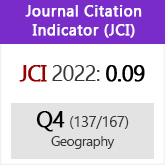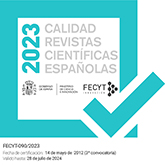Modelización sostenible del emplazamiento de nuevas segundas residencias en el medio rural. El caso de La Vera (Extremadura)
DOI:
https://doi.org/10.3989/estgeogr.201607Palabras clave:
segunda vivienda rural, AHP/OWA, evaluación multi-criterio, toma de decisiones, postura residentesResumen
Se presenta un método de análisis operacional para apoyar la decisión para la implantación sostenible de segundas residencias rurales en un espacio dedicado al ecoturismo: la comarca de La Vera (Extremadura). En este estudio se emplean procesos jerárquicos analíticos (AHP) y promedios ponderados ordenados (OWA) como técnicas de modelado con múltiples atributos junto a las capacidades que ofrecen los sistemas de información geográfica (SIG). Se analizan seis criterios seleccionados de forma restrictiva y otros doce de forma no restrictiva, basados en todas las características posibles de las políticas de planeamiento existentes junto con dos procedimientos analíticos: encuesta a los residentes locales y grupos de discusión de expertos. A través de operadores del OWA con valor constante del orness y máxima entropía, los lugares óptimos para la localización de las segundas residencias rurales se representan en el área de estudio para evaluar las implicaciones ambientales actuales y predecir las mejoras futuras.
Descargas
Citas
Allen, L. R., Hafer, H. R., Long, P. T. y Perdue, R. R. (1993): "Rural residents' attitudes toward recreation and tourism development", Journal of Travel Research, 31/4, pp. 27-33. http://dx.doi.org/10.1177/004728759303100405
Andereck, K. L., Valentine, K. M., Knopf, R. C. y Vogt, C. A. (2005): "Residents' perceptions of community tourism impacts", Annals of Tourism Research, 32/4, pp. 1056-1076. http://dx.doi.org/10.1016/j.annals.2005.03.001
Bell, S. (1995): Elements of visual design in the landscape, London, E&FN Spon.
Blaschke, T. (2006): "The role of the spatial dimension within the framework of sustainable landscapes and natural capital", Landscape and Urban Planning, 75, pp. 198-226. http://dx.doi.org/10.1016/j.landurbplan.2005.02.013
Böhme, K. y Schön, P. (2006): "From Leipzig to Leipzig: territorial research delivers evidence for the new territorial agenda of the European Union", disP, 165/2, pp. 61-70.
Byrd, E. T., Cardenas, D. A. y Dregalla, S. E. (2009): "Differences in stakeholder attitudes of tourism development and the natural environment", e-Review of Tourism Research, 7/2, pp. 39-51.
Carver, S. (1999): "Developing Web-based GIS/MCE: improving access to data and spatial decision support tools", en J. C. Thill (ed.), Spatial Multicriteria Decision making and Analysis, Aldershot, England, Ashgate, pp. 49-75.
Council of the European Union (2001): "Council resolution on architectural quality in urban and rural environments (2001/C 73/04)", Official Journal of the European Communities, C73, 6/3/2001.
De Vriesa, S., de Grootb, M. y Boersb, J. (2012): "Eyesores in sight: quantifying the impact of man-made elements on the scenic beauty of Dutch landscapes", Landscape and Urban Planning, 105, pp. 118-127. http://dx.doi.org/10.1016/j.landurbplan.2011.12.005
Drumm, A. (1998): "New approaches to community-based ecotourism management. Learning from Ecuador", en K. Lindberg, M. E. Wood y D. E. Hawkins (eds.), Ecotourism: a guide for planners and managers, Vermont, The Ecotourism Society, pp. 197-213.
Eagles, P. F. J., McCool, S. F. y Haynes, C. F. (2002): Sustainable tourism in protected areas: guidelines for planning and management, Gland, International Union for the Conservation of Nature. http://dx.doi.org/10.1079/9780851995892.0000
Eastman, J. R. (2003): IDRISI Kilimanjaro: guide to GIS and image processing, Worcester, Clark Laboratories, Clark University.
Fernandez-Salido, J. M. y Murakami, S. (2003): "Extending Yager's orness concept for the OWA aggregators to other mean operators", Fuzzy Sets and Systems, 139, pp. 515-542. http://dx.doi.org/10.1016/S0165-0114(02)00369-X
Fuller, R. y Majlender, P. (2001): "An analytic approach for obtaining maximal entropy OWA operator weights", Fuzzy Sets and Systems, 124, pp. 53-57. http://dx.doi.org/10.1016/S0165-0114(01)00007-0
Gallent, N. y Tewdwr-Jones, M. (2000): Rural second homes in Europe – examining housing supply and planning control, Aldershot, England, Ashgate.
García Moruno, L., Hernández Blanco, J., Ayuga Téllez, F. y García Navarro, J. (1998): "Localizacion de las construcciones en el ámbito rural ante la protección del paisaje", Informes de la Construcción, 50/458, pp. 61-70. http://dx.doi.org/10.3989/ic.1998.v50.i458.879
Gemitzi, A., Petalas, C., Tsihrintzis, V. y Pisinaras, V. (2007): "Assessment of groundwater vulnerability to pollution: a combination of GIS, fuzzy logic and decision making techniques", Environmental Geology, 51, pp. 797-811. http://dx.doi.org/10.1007/s00254-006-0359-1
Guevara, J. R. Q. (1996): "Learning through participatory action research for community ecotourism planning", Convergence, 29/3, pp. 24-40.
Hermann, S. y Osinski, E. (1999): "Planning sustainable land use in rural areas at different spatial levels using GIS and modelling tools", Landscape and Urban Planning, 46, pp. 93-101. http://dx.doi.org/10.1016/S0169-2046(99)00050-X
INE (2011): Instituto Nacional de Estadística, http://www.ine.es/jaxi/menu.do?type= pcaxis&path=%2Ft20%2Fe260%2Fa2011%2F&file=pcaxis&N=&L=0 (Fecha de consulta: 16/04/2014).
Jaraíz, F. J., Mora, J., Gutiérrez, J. A. y Jeong, J. S. (2013): "Comparison of regional planning strategies: countywide general plans in USA and territorial plans in Spain", Land Use Policy, 30/1, pp. 758-773. http://dx.doi.org/10.1016/j.landusepol.2012.06.001
Jeong, J. S., García-Moruno, L. y Hernández-Blanco, J. (2012): "Integrating buildings into a rural landscape using a multi-criteria spatial decision analysis in GIS-enabled web environment", Biosystems Engineering, 112/2, pp. 82-92. http://dx.doi.org/10.1016/j.biosystemseng.2012.03.002
Jeong, J. S., García-Moruno, L. y Hernández-Blanco, J. (2013): "A site planning approach for rural buildings into a landscape using a spatial multi-criteria decision analysis methodology", Land Use Policy, 32, pp. 108-118. http://dx.doi.org/10.1016/j.landusepol.2012.09.018
Jeong, J. S., García-Moruno, L. y Hernández-Blanco, J. (2014): "Un modelo WEB para la asistencia en la toma de decisiones en la integración de las construcciones rurales mediante planificación espacial multi-criterio", Informes de la Construcción, 66/533, e004. http://dx.doi.org/10.3989/ic.13.001
Jeong, J. S., Hernández-Blanco, J. y García-Moruno, L. (2014): "Approaches to validating a mutual participatory web-planning interface in rural Extremadura (Spain)", Land Use Policy, 39, pp. 211-223. http://dx.doi.org/10.1016/j.landusepol.2014.02.014
Jeong, J. S., Montero-Parejo, M. J., Hernández-Blanco, J. y García-Moruno, L. (2015): "The visual evaluation of rural areas: a methodological approach for the spatial planning and color design of scattered second homes with an example in Hervás, Western Spain", Land Use Policy, 46, pp. 330-340. http://dx.doi.org/10.1016/j.landusepol.2015.04.001
Lai, P. H. y Nepal, S. K. (2006): "Local perspectives of ecotourism development in Tawushan Nature Reserve, Taiwan", Tourism Management, 27/6, pp. 1117-1129. http://dx.doi.org/10.1016/j.tourman.2005.11.010
LESOTEX (2001): Guía práctica de aplicación de la Ley 15/2001 del suelo y ordenación territorial de Extremadura, http://sitex.juntaex.es/sias/Documentacion/guia_prac tica.pdf (Fecha de consulta: 6/09/2014).
Malczewski, J. (1999): GIS and multicriteria decision analysis, New York, John Wiley & Sons.
Malczewski, J. (2004): "GIS-based land-use suitability analysis: a critical overview", Progress in Planning, 67, pp. 3-65. http://dx.doi.org/10.1016/j.progress.2003.09.002
Morales Yago, F. J. (2013): "El impacto de la actividad turística sobre el paisaje de La Manga del Mar Menor (Murcia)", Estudios Geográficos, 74/275, pp. 523-556. http://dx.doi.org/10.3989/estgeogr.201319
NATURA (2000): European commission environment for nature & biodiversity policy, http://ec.europa.eu/environment/nature/natura2000/index_en.htm (Fecha de consulta: 23/07/2014).
Page, S. y Dowling, R. K. (2002): Ecotourism, Harlow, Pearson Education. Ross, S. y Wall, G. (1999): "Ecotourism: towards congruence between theory and practice", Tourism Management, 20/1, pp. 123-132.
Roy, B. (1996): Multicriteria methodology for decision aiding, Dordrecht, Kluwer Academic Publishers. http://dx.doi.org/10.1007/978-1-4757-2500-1
Saaty, T. L. (1977): "A scaling method for priorities in hierarchical structures", Journal of Mathematical Psychology, 15, pp. 234-281. http://dx.doi.org/10.1016/0022-2496(77)90033-5
Tandy, C. (1979): Industria y paisaje, Madrid, Ed Leonard Hill Books. PMid:457570
Tassinari, P. y Torreggiani, D. (2006): "Location planning: a methodological approach for agro-industrial buildings in rural territory", Transactions of the ASAE, 49/2, pp. 505-516. http://dx.doi.org/10.13031/2013.20405
Tewdwr-Jones, M., Gallent, N. y Mace, A. (2002): Second homes and holiday homes and the land use planning system, Cardiff, Welsh Assembly.
Teye, V., Sirakaya, E. y Sönmez, S. (2002): "Residents' attitudes toward tourism development", Annals of Tourism Research, 29/3, pp. 668-688. http://dx.doi.org/10.1016/S0160-7383(01)00074-3
Vepsäläinen, M. y Pitkänen, K. (2010): "Second home countryside. Representations of the rural in Finnish popular discourses", Journal of Rural Studies, 26, pp. 194-204. http://dx.doi.org/10.1016/j.jrurstud.2009.07.002
Vincent, V. C. y Thompson, W. (2002): "Assessing community support and sustainability for ecotourism development", Journal of Travel Research, 41/2, pp. 153-160. http://dx.doi.org/10.1177/004728702237415
Von Winterfeldt, D. y Edwards, W. (1986): Decision analysis and behavioral research, Cambridge, Cambridge University Press. PMid:3602513
Weaver, D. B. (2001): Ecotourism, Milton, Qld, John Wiley & Sons.
Weaver, D. B. y Lawton, L. J. (2007): "Twenty years on: the state of contemporary ecotourism research", Tourism Management, 28/5, pp. 1168-1179. http://dx.doi.org/10.1016/j.tourman.2007.03.004
WFD (2000): Directive 2000/60/EC of the European Parliament and of the Council of 23 October 2000 establishing a framework for Community action in the field of water policy, http://eur-lex.europa.eu/LexUriServ/LexUriServ.do?uri=CELEX32000L0060:EN:NOT (Fecha de consulta: 17/10/2014).
Yager, R. R. (1988): "On ordered weighted averaging aggregation operators in multicriteria decision making", IEEE Transactions on Systems, Man, and Cybernetics, 8, pp. 183-190. http://dx.doi.org/10.1109/21.87068
Zhang H. y Lei, S. L. (2012): "A structural model of residents' intention to participate in ecotourism: the case of a wetland community", Tourism Management, 33, pp. 916-925. http://dx.doi.org/10.1016/j.tourman.2011.09.012
Descargas
Publicado
Cómo citar
Número
Sección
Licencia
Derechos de autor 2016 Consejo Superior de Investigaciones Científicas (CSIC)

Esta obra está bajo una licencia internacional Creative Commons Atribución 4.0.
© CSIC. Los originales publicados en las ediciones impresa y electrónica de esta Revista son propiedad del Consejo Superior de Investigaciones Científicas, siendo necesario citar la procedencia en cualquier reproducción parcial o total.Salvo indicación contraria, todos los contenidos de la edición electrónica se distribuyen bajo una licencia de uso y distribución “Creative Commons Reconocimiento 4.0 Internacional ” (CC BY 4.0). Puede consultar desde aquí la versión informativa y el texto legal de la licencia. Esta circunstancia ha de hacerse constar expresamente de esta forma cuando sea necesario.
No se autoriza el depósito en repositorios, páginas web personales o similares de cualquier otra versión distinta a la publicada por el editor.
















